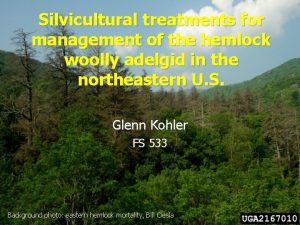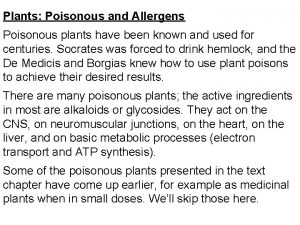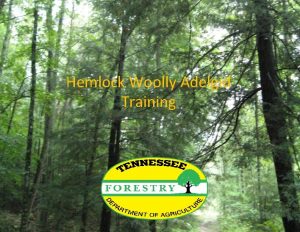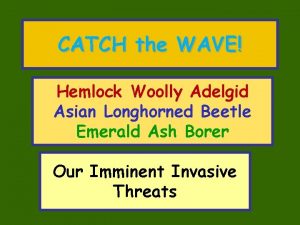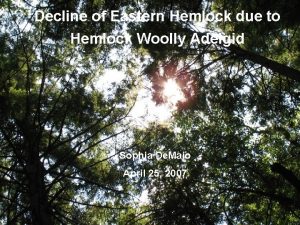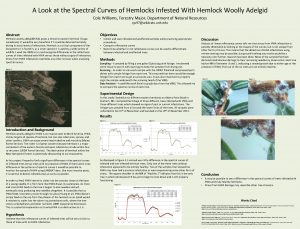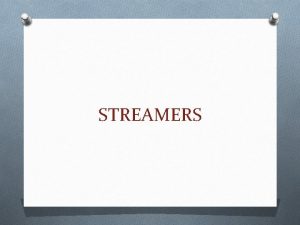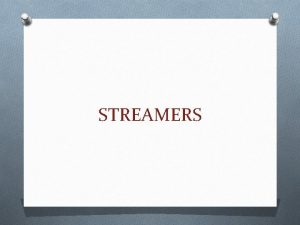Our Catskill Hemlocks HEMLOCK WOOLY ADELGID EDUCATION AND














- Slides: 14

Our Catskill Hemlocks HEMLOCK WOOLY ADELGID, EDUCATION AND TREATMENT OPTIONS AUGUST 30 TH, 2019

Table of Contents ØBenefits of Hemlocks to our landscape ØThe Hemlock Wooly Adelgid (HWA) ØIntroduction ØIdentification ØTreatment ØClose ØAppendix ØContact information ØResources

Benefits of Hemlocks to our landscape

Hemlocks are a very beneficial tree to the Catskills Hemlock trees are a key component of the canopy forest in the Catskill area of New York State. They provide the deepest shade on the East Coast. Among their many benefits, Hemlocks: Ø Grow in steep slopes and poor soils of our streams and lakes, providing shade/cool waters where fish thrive, and reducing run-off into our waterways ØWhere Hemlocks are lost, fishing and water quality decrease due to increased nutrient loads (Brook trout are 4 x larger in Hemlock-shaded waterways) ØHemlocks provide forage areas for deer, birds, porcupines, and many woodland animals, catching snow in winter providing open ground for animals to feed ØHemlocks provide needed nutrients to acidic soils ØHemlocks draw-up water, preventing snow melt flooding

The Hemlock Wooly Adelgid (HWA)

The Hemlock Wooly Adelgid ØThe Hemlock Wooly Adelgid (HWA) was introduced to the US in 1951, likely from garden ornamentals imported from Japan, and spread to NY in the early 1990’s ØThere is a different variety of HWA on the West Coast, that was introduced from China Ø 25 -30% of the East Coast is infected with HWA, including Sullivan Country, NY ØHWA is spread by wind, mammals, birds, humans ØTrees infected with HWA are more susceptible to drought stress ØWithout treatment, trees infected with HWA will die within 6 -10 years

Identifying the Hemlock Wooly Adelgid ØHWA live at the base of needles, typically on the underside on a series of branches ØYou’d need a 10 x magnifying glass to see the eggs and nymphs, but can see the wooly covered adult HWA with your bare eyes ØThe HWA suck the starch reserves from the tree at the base of the needle and inject their saliva, the tree has hyper-sensitivity to this which kills the water movement, and then over the long-term, kills the tree ØYou’re more likely to see the wool in fall and late winter ØApril and Sep/Oct are most likely time to spread the HWA, as the aphids are at various crawling stages ØEarly infestations typically take place in the upper canopy, making it harder to ID

Treating the Hemlock Wooly Adelgid There are treatments for HWA: ØThe most common treatment is spraying or tree injections, using various insecticides, that should be applied by a certified arborist ØOptimal treatment times are spring and fall ØYou need to treat forever, but you don’t have to treat every year ØBiocontrol is the most promising option for long-term treatment and for sustaining the Hemlocks ØSeveral beetle releases are being tested in NY State under rigorous conditions to ensure there is no chance of host switching; there have been successful releases in PA, WV, VA ad TN ØThere is a lot of optimism for a breed of silver fly, whose larvae feeds on HWA eggs ØThis is being tested in multiple NY locations, although there is no firm establishment yet ØTree hybridization has been tried, with little success ØThe wetter the area, the stronger the Hemlocks are

In closing…. and how we can help Unfortunately, the HWA is here to stay…the good news is that in certain parts of the country, a beetle that eats the HWA has been introduced and is thriving In the near term, the only way to save Hemlock trees is to treat them – the HWA can be successfully treated with insecticides – treat the trees you wish to keep ØGroup rates are available for arborist who are hired to treat many trees at one time The NY State Department of Environmental Conservation (DEC) & Cornell NEED OUR HELP ØTree surveys - http: //nyis. info/invasive_species/hemlock-woolly-adelgid/ ØVolunteers for treatment programs – Cornell is looking for 8 -10” tall hedgerows for field testing ØProviding food for their beetle populations – Cornell will pick-up infested tree branches

Appendix

Resources All information in this presentation comes from notes taken at the New York Department of Environmental Conservation educational meeting, attended June 13, 2019, in Woodstock, NY, by James & Lori Harr Visit NY DEC website for information and additional fact sheets on HWA, https: //www. dec. ny. gov/animals/7250. html Also, Cornell has a wonderful Hemlock conservation program, led by Mark Whitmore https: //blogs. cornell. edu/nyshemlockinitiative/hemlock-woolly-adelgid/why-hemlocktrees/ https: //blogs. cornell. edu/nyshemlockinitiative/home/our-team/ Someone from the NY DEC will come to our club to speak on the HWA if we’d like them to – contact Lori Harr if interested Double-click icon to open fact sheet

Hemlock Q&A Q: At what point of infestation should you remove the Hemlock tree? A: In areas that have been commercially thinned, and therefore have increased light on the trees, have seen a decrease in HWA – but there is no specific time recommended for tree removal Q: How do you dispose of infested tree parts? A: Leave the branches on the ground, in the woods near the tree, do not move them to a new area Q: Is it worth it to treat your trees if others near you are not? A: Treat the trees you wish to save

Image of an infested Hemlock forest Note the graying die-back

Extent of Eastern Infestation as of 2017
 Hemlock woolly adelgid
Hemlock woolly adelgid Quien quiere ir al cine conmigo
Quien quiere ir al cine conmigo Poison hemlock range
Poison hemlock range Catskill center for independence
Catskill center for independence Awareness of ourselves and our environment is
Awareness of ourselves and our environment is Awareness of ourselves and our environment is
Awareness of ourselves and our environment is Our awareness of ourselves and our environment.
Our awareness of ourselves and our environment. Our awareness of ourselves and our environment
Our awareness of ourselves and our environment Thinking affects our language which then affects our
Thinking affects our language which then affects our Our census our future
Our census our future Christ be our light shine in our hearts
Christ be our light shine in our hearts Our life is what our thoughts make it
Our life is what our thoughts make it We bow our hearts
We bow our hearts Our census our future
Our census our future Our life is what our thoughts make it
Our life is what our thoughts make it
